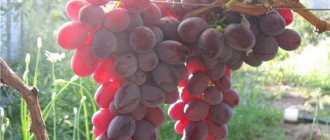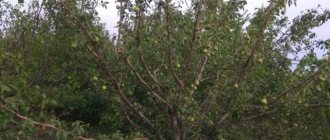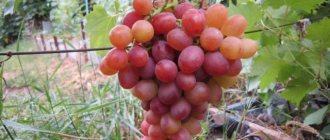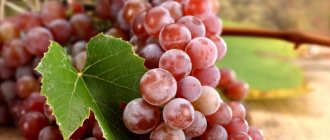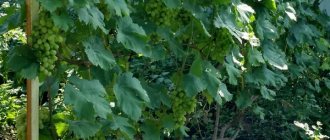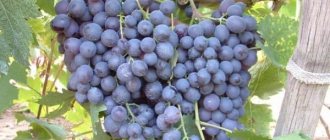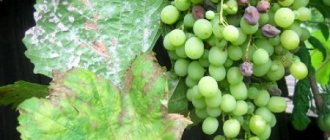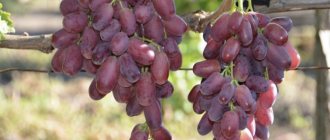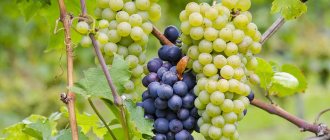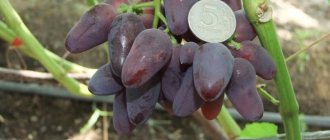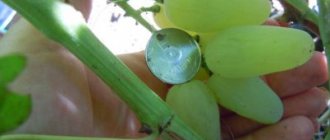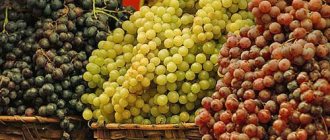Advantages and disadvantages
Like any other variety, “Jubilee Novocherkassk” has its advantages and disadvantages.
Pros:
- Presentable appearance of the brushes.
- An impressive mass of bunches and berries.
- High and stable yield.
- Pleasant harmonious taste.
- Good ripening of shoots.
- The variety is relatively unpretentious to care for.
- Drought and frost resistance.
- Resistance to fungal diseases is above average.
- Suitable for long-term transportation and storage.
- Commercial benefit from the sale.
Minuses:
- The need for regular pruning and crop regulation.
- Vulnerability to wasps.
- The need for regular treatment with fungicides.
Harvest and storage
Harvesting depends on the climatic and weather characteristics of the region where the fruit crop grows. In the middle zone, grapes are harvested in early or mid-September. Ripened brushes in a refrigerator can retain their taste and presentation for up to 2 weeks. In specialized chambers, grapes are stored for 2 to 3 months.
Origin
The “author” of the Novocherkassk Anniversary variety is the famous breeder V.N. Krainov, whose track record includes more than one variety of high-quality grapes. It is not known exactly which species were crossed to produce the “jubilee”. Experts suggest that the “parents” were “kishmish radiata” and “talisman”.
Parents of “Anniversary of Novocherkassk” - “Radiant Kishmish” and “Talisman”
The hybrid was entered into the State Register of Russia only in 2016, although the patent documents were filed two years earlier.
Main characteristics
“Yubilei Novocherkassk” is an early table grape variety with excellent commercial characteristics.
Ripening period
“Anniversary of Novocherkassk” is an early ripening variety. Full ripening of the berries occurs 110–120 days after the buds swell on the bush in early spring. Typically harvested in early or mid-August depending on the region and prevailing weather conditions.
Bush
The bush of the variety is spreading and powerful. The shoots grow very quickly and require constant monitoring by the winegrower. The foliage is dark green, the leaves are five-lobed with carved edges and clearly visible veins, the flowers are bisexual.
Reference! The recommended shape for the bush is fan-shaped: this will greatly simplify the process of caring for a fast-growing vine.
Bunches and berries
The bunches of the “Jubilee of Novocherkassk” are conical in shape and dense in structure. They amaze not only with their beautiful appearance, but also with their weight: the average weight of the brushes is 1 kg, but with proper care the weight can reach 3 kg!
Each berry weighs about 12 - 18 grams, their average size is 5 by 4 cm. The elongated grapes are colored pink-yellowish, some are pink with a white tint. The peel is dense, but chews easily. The flesh is fleshy and dense. There are seeds inside the pulp, but they are small and do not spoil the taste of the berry.
Sugar content is 16 - 17% with an acid content of 6 grams per liter of juice.
Reference! Unripe Novocherkassk Jubilee grapes are very sour. A characteristic feature of the variety is the fact that the berries are filled with sugar literally a week before they are fully ripe, despite the fact that the appearance begins to look appetizing even earlier than this.
The taste of the grapes is pleasant, harmonious, without pronounced shades.
Productivity
The variety is distinguished by regular and abundant harvest. With proper plant care measures, one bush of the Novocherkassk Jubilee variety can produce up to 20 kilograms of fruit.
Ripe bunches can hang on the bush until the end of September, without losing their presentation and excellent taste characteristics.
Usage
The Novocherkassk variety is considered a table variety, so its main area of use is fresh consumption. It can be used in cooking as one of the ingredients in salads, desserts, the berries are often added to baked goods, and jam or jam is made from them.
Producing wine in large quantities from this variety is not profitable, but it is quite possible for those at home. The maximum profit for the winegrower will come from the sale of bunches of grapes, since the variety is distinguished by excellent external and taste characteristics.
Description of the variety Jubilee Novocherkassk
Also check out these articles
- Pear compote
- Garlic Rocambole
- Growing dill in a greenhouse in winter
- Texas quail
The bushes are vigorous, develop quickly, and therefore require regular pruning. The vine grows both in width and length. Grafted seedlings and own-rooted ones have these qualities. The clusters are large - the average can reach 1.5 kg, but there are also record holders up to 3 kg! The plant has flowers of both sexes, so it blooms early. The shape of the bunch is elongated-conical, not very dense.
After full ripening, the berries acquire a pink skin color, but may have a yellowish or white tint. The shape is oval, slightly elongated. The weight of one berry is 11-19 g, length and width are 3.8x2.3 mm, respectively. The skin is medium in density and is almost unnoticeable when eating. The pulp is fleshy with an abundance of juice. The taste of ripe berries is sweet, simple, without shades.
The shape is oval, slightly elongated, the flesh is fleshy with an abundance of juice.
Comparison with analogues
The table below shows the comparative characteristics of the best pink grape varieties bred by V. Krainov.
| Sign | Variety | |||
| Anniversary of Novocherkassk | Transfiguration | Helios | Angelica (Ksenia) | |
| Ripening period | 1150 – 120 days | 115 days | 110 days | 105 – 110 days |
| Frost resistance | -23C | -23C | -23C | -23C |
| Productivity | Up to 20 kg | Up to 20 kg | 6 – 10 kg | 6 kg |
| Bunches | 700 – 3000g | 700 – 1000 g | 800 – 1200 g | 700 – 1500 g |
| Taste | Harmonious | Harmonious | Muscat | Harmonious |
| Color | Pink with white and yellow shades | Pink | Pink | Yellow-pink |
| Disease resistance | Above average | Average | Above average | Above average |
| Shelf life | 1 month | 1 month | 1 – 2 months | 1 – 2 months |
| Sugar accumulation | 16,50% | 19% | 22% | 17 – 20% |
| Acidity | 6g/l | 7 g/l | 6 – 8 g/l | 8 g/l |
Rules of care
Caring for grape bushes involves timely watering, fertilizing and pruning.
Watering
Jubilee Novocherkassk grapes are not demanding when it comes to watering. During the growing season, the bushes are watered only 3-4 times. Irrigation work is carried out in early spring, before the fruit crop enters the flowering phase and during the period of fruit formation. The last watering is carried out before wintering, pouring up to 70 liters of moisture under each bush.
Young seedlings are more demanding of moisture, so in the first year of growth, watering is carried out as the soil dries.
Mulching
Work on weeding, loosening and mulching the tree trunk circle is timed to coincide with watering.
See also
Description and types of diseases and pests of grapes, treatment and control of them
Read
The soil under the bush is thoroughly loosened, weeds and roots are removed, and a layer of peat and wet sawdust mulch is laid on top.
Top dressing
If the seedlings are planted correctly, they begin to feed the grapes in the 3rd year of growth in open ground:
- At the beginning of spring, nitrogen-containing organic matter is added to the soil.
- During the period of flowering and fruit formation, the bushes need mineral supplements containing phosphorus and potassium.
- In the autumn, grapes are fed with organic matter and a balanced mineral complex.
Important! Before winter rest, I mulch the tree trunk circle with a thick layer of humus or compost.
Formation
The Yubilei Novocherkassk grape bushes are prone to overgrowth and therefore require careful and timely pruning. Also, when pruning, plants are given the desired shape, weak, frozen, deformed and damaged branches and shoots are removed.
In grape bushes, many shoots form on the fruiting shoots, which need to be monitored and pruned. Also, excess inflorescences are removed from the vine, leaving 1-2 clusters per fruitful shoot.
In the southern regions, at the end of September, the second grape harvest ripens on the stepsons, although the clusters and berries no longer have large shapes and sizes.
Preventive spraying
For prevention, grape bushes are annually sprayed with complex chemical and biological means of protection against diseases and pests.
The work is carried out in early spring, before the onset of the growing season, and after the berry harvest.
Protection from wasps and birds
Large, juicy berries are a delicacy for birds and wasps, which feed on the juice of the fruit. In garden centers, it is recommended to purchase special nets for grape clusters that protect the berries from the penetration of birds and insects.
Shelter for the winter
In southern latitudes, Jubilee Novocherkassk grapes do not require additional insulation. The bushes are watered abundantly, and the tree trunk circle is mulched and covered with spruce branches.
In the conditions of the middle zone, grape shoots are removed from the supports, laid on dry leaves and covered with special fiber or burlap on top.
In the northern regions, grape shoots are covered with special material and sprinkled with earth and snow on top.
Weeding and loosening
Weeds can cause irreparable harm to grape bushes, spreading many pests, fungi and viruses. Therefore, weeding work is carried out as necessary.
Through loose soil, plant rhizomes gain access to oxygen and useful nutrients.
Features of cultivation
“Anniversary of Novocherkassk” has good disease resistance and requires mandatory rationing and covering of bushes for the winter.
Landing
Planting of the “Jubilee of Novocherkassk” should be done at a time when the weather is consistently warm, the air warms up to +15ºС, and the soil to +10ºС. The best option for planting seedlings is the first half of April. But it is better to graft the cuttings to the rootstock in the fall.
Place and soil
The southern plant needs plenty of sun and reliable protection from the wind. Since the bush of the variety is powerful and spreading, it is better to plant it near a strong support. This role can be played by the walls of outbuildings, houses, as well as a fence. The ideal option is their southern side: this way the sun can heat the vines of the plant to the maximum.
“Jubilee Novocherkassk” is unpretentious in terms of soil type, but black soil or loam is ideal for it. Growing in such soil, the plant will give significant growth and excellent quality of fruit. Also, groundwater should not wash away the roots of the plant, otherwise it will get sick and sooner or later die. If it is not possible to get rid of excess moisture on the site, then the winegrower will need to carefully consider the composition of the drainage.
The technology for planting this variety is no different from the classic one. A layer of humus is poured into the bottom of a meter-long hole (diameter and depth - 1 m), followed by ordinary soil, on top of which the roots of the grapes are placed. Having carefully spread them over the surface of the soil, the hole is filled with earth and lightly compacted to fix the seedling.
The final stage of planting is abundant watering with water (10 - 15 l).
Watering and fertilizers
It is necessary to water the “Jubilee of Novocherkassk” only when the soil layer is sufficiently dry. If natural precipitation occurs, you can skip watering.
Be sure to water the plant twice: before flowering and after the flowers wither. Young bushes up to a year old - once a week.
You can prevent moisture evaporation by mulching the soil. A three-centimeter layer of humus or peat around the crop trunk is an excellent solution that will not only preserve the moisture supply of the roots, but also nourish them.
It is necessary to feed the plant 2-3 times a year: in the warm season - with mineral fertilizers, in the fall - with organic fertilizers.
Important! Potassium and phosphorus are mandatory components of mineral supplements, since these elements affect the yield and taste of fruits.
Trimming
It is impossible to leave the rapidly growing bush of grapes “Jubilee Novocherkassk” without pruning and rationing the harvest.
The optimal time for pruning is early spring or late autumn, when sap flow has not yet begun in the plant. For a rich harvest and normal development of the bush, experienced winegrowers recommend leaving 22 - 24 shoots, on which the total number of fruit buds should not exceed 45. The shoots are shortened once a year to the first bud.
After the clusters have formed, they must be thinned out, leaving no more than one cluster on each shoot.
Diseases and pests
“Yubilei Novocherkassk” has good resistance to mildew, oidium and gray rot. However, it would benefit from preventative treatment 2–3 times per season against these fungal diseases. This event will provide a reliable guarantee that the grape harvest will be preserved.
Irrigation must be carried out with drugs that act directly on each disease separately. The best time: before and during the flowering of grapes, as well as after fruit set. Do not forget about preventive measures in relation to other “grape” diseases: anthracnose, bacteriosis, chlorosis, rubella, bacterial cancer.
Important! An excess of water in the soil is a direct path to the development of fungal diseases. To avoid such a phenomenon, the winegrower should take care that the soil is not swampy and that groundwater does not lie close to the roots.
The greatest damage to crops can be caused by wasps, which are attracted by the sweet taste of aromatic berries. You can protect the crop by placing special baits near the bushes, destroying wasp nests, and also by using special nets placed on the bunches.
Wintering
Internet sources indicate that the “anniversary of Novocherkassk” can tolerate frosts down to -23ºС without shelter. However, experienced winegrowers still recommend insulating this variety for the winter: the “behavior” of the plant is quite unpredictable.
In the south, it is enough to get by with a simple option: insulate the vines with burlap and hay, wrapping them around the wood of the plant. In regions located to the north, the plant's lashes must be removed from the support, pressed to the soil surface, sprinkled with soil and snow. Young seedlings require mandatory insulation, including in southern latitudes.
How long can the crop be stored?
The “anniversary” harvest can easily lie without deterioration in external and taste characteristics for 10 days in room conditions, in a cellar at a temperature of 0ºC - + 3ºC and high humidity - up to a month.
The dense skin of the berries protects the grapes from cracking and mechanical damage during long-term transportation , so the variety can be transported over long distances without fear.
Cultivation regions
“Anniversary of Novocherkassk” is recommended to be grown in southern latitudes: Krasnodar Territory, Stavropol Territory, Rostov Region, Crimea, as well as in Ukraine and Moldova. It is also possible to grow the variety in central Russia, provided that the plant is insulated for the winter. But in the Urals and Siberia it is not worth growing these grapes - most likely, the plant will freeze.
Features of planting this variety
We recommend reading our other articles
- Hyacinth flower
- Chicken manure fertilizer
- Phoenix cucumber variety
- Beet pulp (Beet pulp)
Grapes love sun and warmth, so choose a place for planting that is sunny, but protected on 1-2 sides from strong winds. The requirements for the type of soil are low, the main thing is that the composition contains enough fertilizers. Groundwater should lie no higher than 2-3 meters from the soil surface. If they go higher, it is necessary to make a drainage system before planting, otherwise the root system of the plant will begin to rot over time.
The plant can be planted in ridges (if cuttings are planted) or in holes (for young bushes). The distance between seedlings is 1.5 m so that they do not interfere with each other’s growth, and a distance of 1.5-2 meters is maintained between rows. The planting hole is made with a diameter of 50 cm and a depth of about 60 cm. The soil for planting is mixed from simple soil (preferably chernozem), humus or compost, and sand.
Grapes love sun and warmth, so choose a sunny place for planting.
Interesting!
The Jubilee Novocherkassk grape tolerates planting well with young bushes or propagation by cuttings. It quickly takes root in a new place and soon begins to bear fruit.
The seedling is lowered into a hole half-filled with fertile soil, the roots straighten out. Now you can gradually fill the hole with soil mixture. The growth point of the bush should rise 1-3 cm above the ground level. After the hole is filled, watering is carried out.
Beneficial features
Novocherkassk Anniversary grapes are one of the healthiest berries. Its chemical composition promotes the activation of a number of chemical reactions in the body, due to which the process of hematopoiesis improves, which has a positive effect on the condition of the bone marrow.
A huge number of useful vitamins and microelements give grape berries general strengthening and tonic properties, and the antioxidants in its composition have a strengthening effect on the cardiovascular system, help fight free radicals, which only has a positive effect on a person’s health and appearance.
However, you should remember that grapes should not be overused. This berry is quite high in calories: 100 g of Novocherkassk Jubilee fruit contains about 70 kcal. This should be remembered by those who are watching their figure or trying to lose weight. But patients with diabetes need to take into account that 100 g of product contains 17 g of sugar. And besides, the culture is not combined with all dishes, the simultaneous consumption of which can cause bloating and flatulence.
Photo
Read more about the photos and reviews about the “Anniversary of Novocherkassk” variety.
Reviews
Hybrid of early ripening period 110-115 days, vigorous, clusters from 0.8 to 1.6 kg, large berries 12-18 g, harmonious taste. Productivity is high. Frost resistance - 23, disease resistance 3 points. Sergey, Zaporozhye
A very beautiful and large berry and a pleasant taste. When the berries had already turned pink, it rained a little over a week ago, I was worried whether the berries would crack, but no, they were all intact. I think this is a very good variety. Gregory, Poltava region.
The bush is self-rooted, vigorous, and has shown good resistance. Good sugar and very pleasant taste. Elena Petrovna, Rostov region.
What to write about the Anniversary of Novocherkassk?! He needs to be planted! Great grapes! Victor, Lviv
Pests and diseases of the variety
Novocherkassk Jubilee grapes very rarely suffer from mildew, oidium, and gray mold, but this is possible if preventive treatments are not carried out. They are made 2-3 times a year - in early spring, after flowering and in autumn. Drugs are selected at will. The crop will not get sick if you provide it with proper care, do not water it very often so that the ground does not become waterlogged, and carry out preventive treatments.
The simplest method of fighting wasps is to place the bunches in special protective nets.
Of the pests, wasps usually cause the most problems. It is difficult to protect ripe bunches from them. The simplest method is to place the bunches in special protective nets. You can also use baits and repellers. If aphids, caterpillars or similar pests appear on the bushes, insecticides are used against them.
